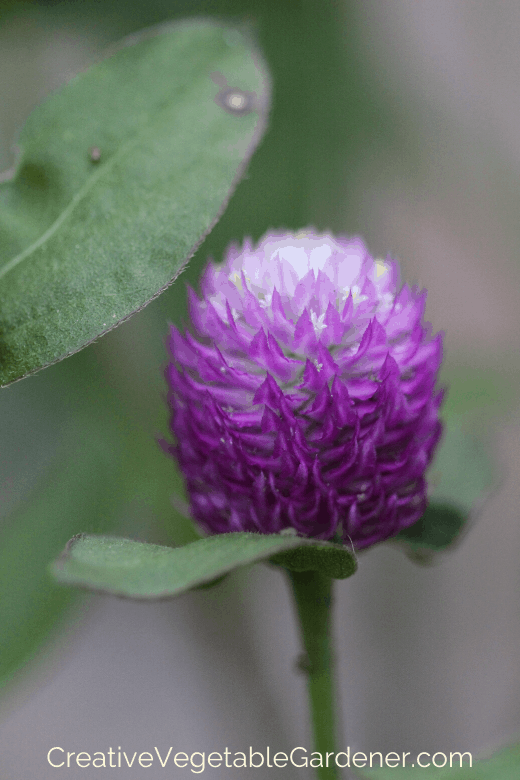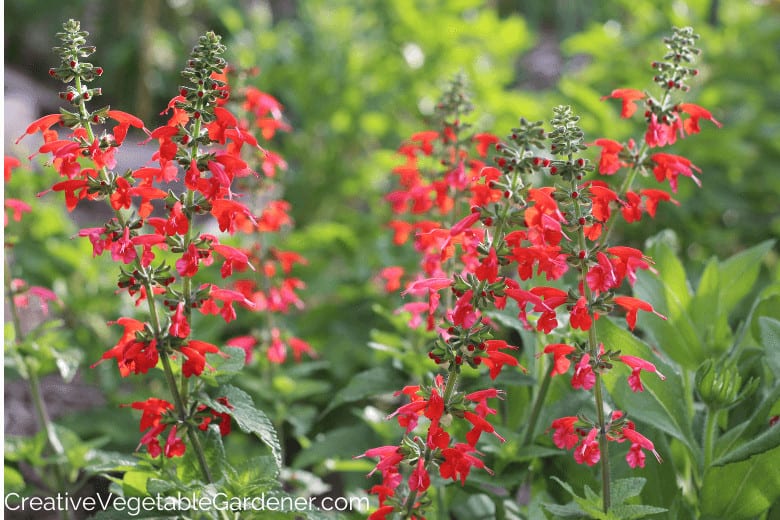
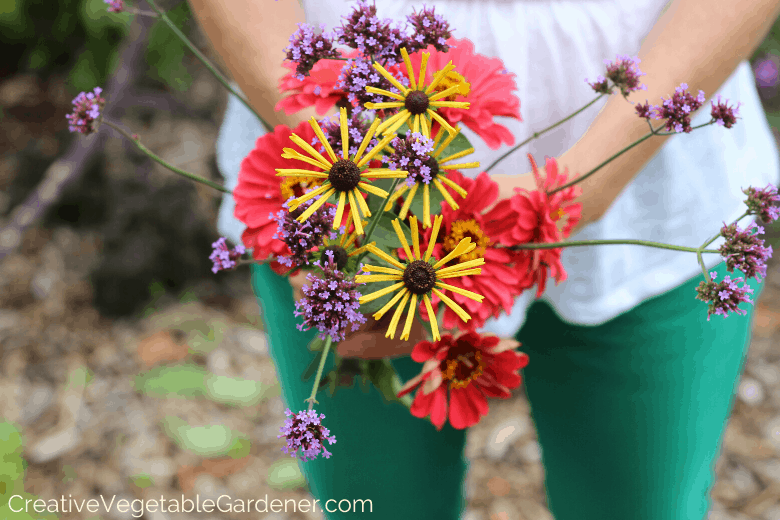
One of my missions is to bust the misconception that vegetable gardens aren’t attractive. I strongly believe that you can have a vegetable garden that produces a lot of food and is beautiful to look at.
What’s the secret?
Plant lots and lots of flowers among your vegetables. Annuals are my flowers of choice, although I also plant spring bulbs in my vegetable beds for some early season color.
Tucking flowers throughout your garden will add colorful pops of beauty to draw the eye into and around the space, attract tons of beneficial insects like bees, butterflies, and hummingbirds, and impress your neighbors because they’ve never seen a vegetable garden looking so good!
In this article, I’ll share the best flowers for raised beds. This list features my absolute favorite flowers I’ve been growing in my vegetable garden for many years.
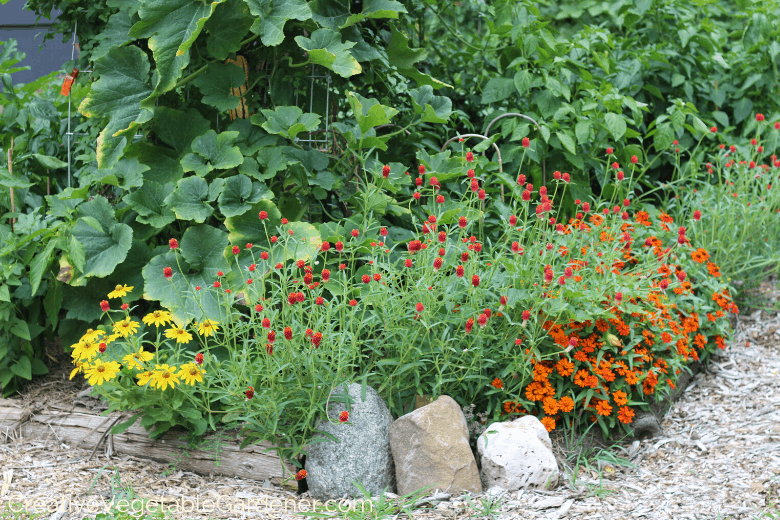
This post contains affiliate links.
There’s nothing quite like the feeling of harvesting a basket full of colorful produce you grew with your own two hands. If you know just what I’m talking about, then I’m pretty sure you’ll also love gathering a bright bouquet of cut flowers just as much.
Luckily, if you’re already a vegetable gardener, it’s incredibly easy to incorporate some flowers into your raised beds so you can harvest beautiful bouquets for yourself and friends all summer long.
Favorite Flowers for Raised Bed Gardening

Zinnias
Nothing screams summer more than a handful of cheery zinnias. Available in a brilliant rainbow of colors, these cut-and-come-again plants are essential for any flower-loving gardener.
As one of the easiest flowers to grow, they are perfect for beginning gardeners. They also do well in a wide range of climates and growing zones.
Favorites include:
Benary’s Giant
Queen Red Lime
Zinderella Lilac
Zinderella Peach
Jazzy Mix
Lots of cool zinnia varieties in this Etsy shop here.
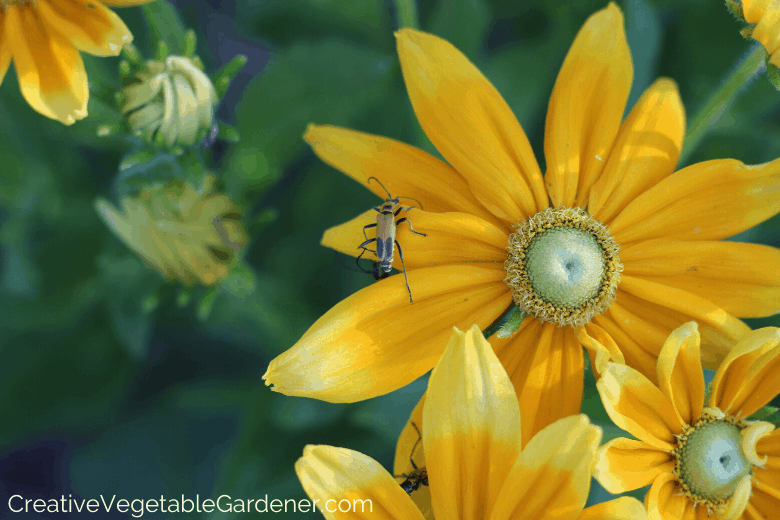
Black-eyed Susan (Rudbeckia hirta)
Black-eyes Susan is commonly seen in perennial and prairie gardens in the Midwest where I live. The good news is that you don’t have to be a perennial flower gardener to grow rudbeckias (as they are also known).
The photo above features the best Black-eyed Susan I’ve ever grown – Prairie Sun. Instead of a black eye (or center), it has more of a green center and two-toned petals featuring complementary yellows.
I’ve also tried and liked
Cherry Brandy (maroon instead of yellow)
Chim Chiminee
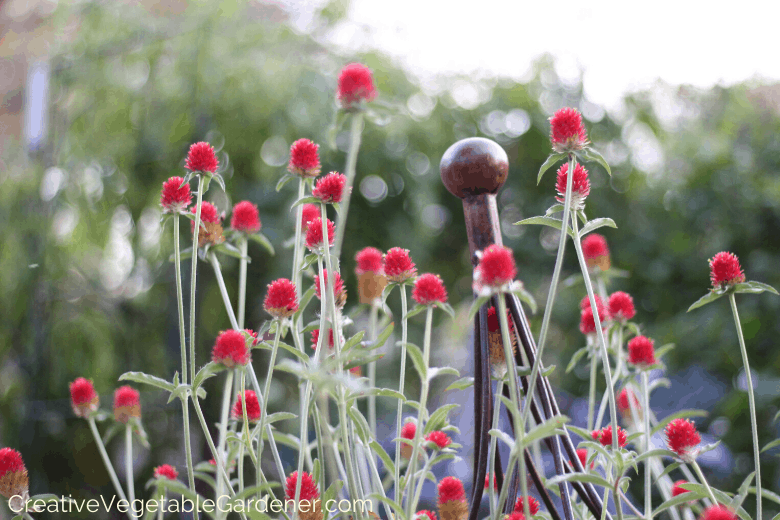
Globe Amaranth (Gomphrena globosa)
I’ve been planting Globe Amaranth as a companion to my vegetables for as long as I can remember. I often rotate the flowers I grow each year, but this one is always on the list!
Many of the varieties are tall and airy, so you easily mix them with your vegetables and they won’t crowd them out.
The blooms last way past your first frost and hold their color when dried so you can use them for winter bouquets as well.
I love Strawberry Fields Gomphrena mixed with Prairie Sun Rudbeckia in the same garden bed. The red and yellow colors pop against each other and the vastly different forms of the plants complement each other well.
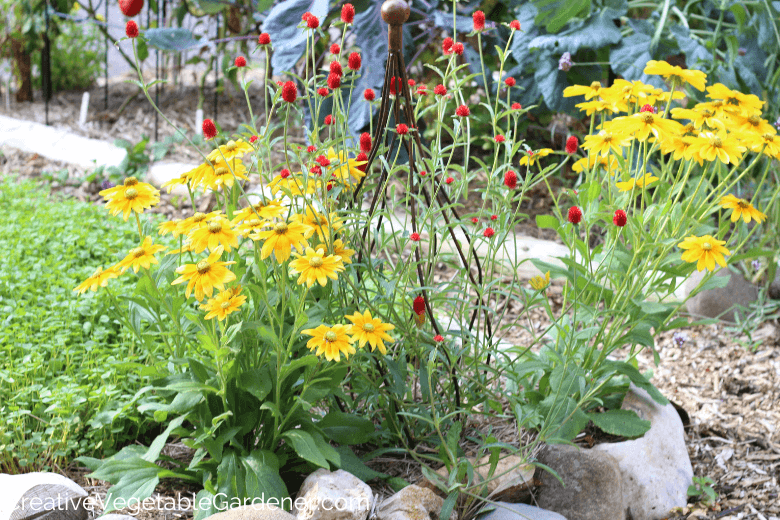
Other favorite varieties
Bicolor Rose
Qis Purple
This Etsy shop has some fun varieties of Gomphrena.
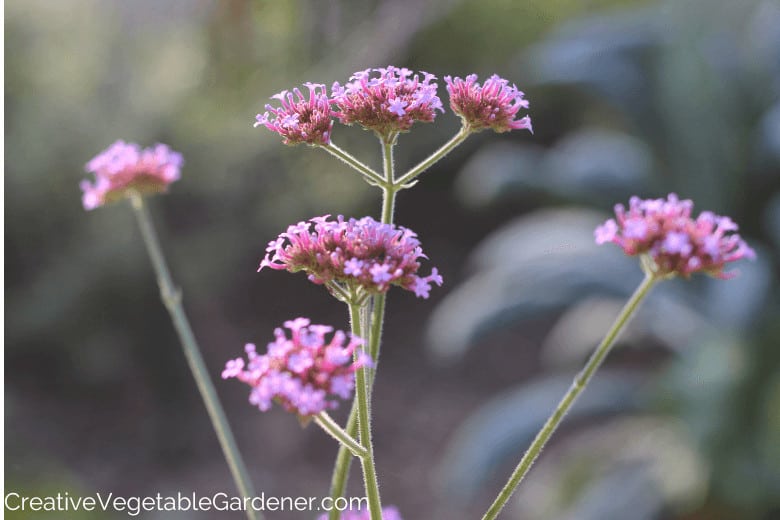
Tall or Purple Top Verbena (Verbena bonariensis)
There are various verbenas out there, but this one is my favorite by far. It’s tall and airy, so I love mixing it will other flowers and vegetables. The insects and pollinators love it and I’ve seen many a butterfly enjoying the flowers. It blooms for a long time – from July until frost.
I’ve tried to start seeds at home without much luck, so I usually purchase a few seedlings at my local nursery in spring. It does re-seed itself pretty aggressively, so I often find little seedlings sprinkled around my garden in late spring. They don’t bother me though. I let some of them grow and weed out the rest.
Verbena bonariensis
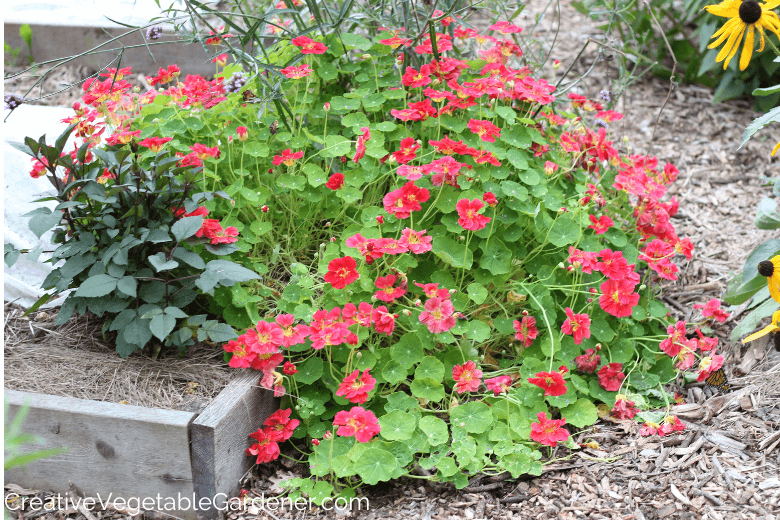
Nasturtium
Until a few years ago, I had no idea that climbing nasturtiums existed! I stumbled upon some seeds while looking around online, ordered them as an experiment, started the seeds in the winter, and planted the seedlings at the foot of my turquoise tuteur (photo below).
Image my surprise and delight upon discovering them slowing climbing up and up throughout the season, all covered in flowers. I fell in love with them! Now I plant several different varieties on the tuteur and at the foot of my cattle panel trellises.
There are also mounding nasturtiums, which I also plant some years. In my garden they tend to get huge and sprawling, so sometimes I skip planting them for that reason.
In the last few years, I’ve noticed many more interesting and unique varieties being introduced. Some of my favorites:
Moonlight Climbing Nasturtium
Climbing Phoenix Nasturtium
Cherries Jubilee Mounding Nasturtium
Bloody Mary Mounding Nasturtium
Orchid Cream Mounding Nasturtium

Salvia
If you want a hummingbird magnet in your garden, then scatter some Lady in Red Salvia throughout your raised beds. It continues to bloom all summer long into fall and I also love this one mixed with the yellow flowers of Prairie Sun Rudbeckia.
There are lots of colors of salvia out there, but the red and blue are my favorites.
Victoria Blue
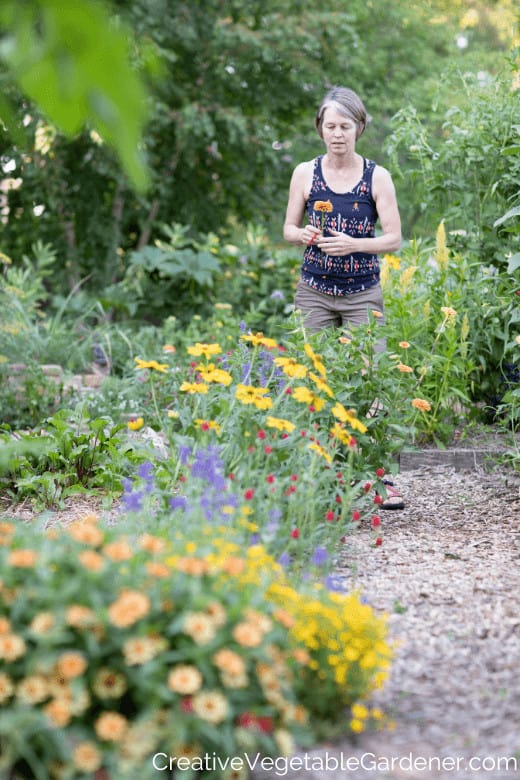
Where To Buy Flower Seeds and Plants
Buying Seeds
If you already have a favorite seed company you should be able to find great varieties of flowers for raised beds in their catalog. Some of the varieties we talked about in this blog post are a little more difficult to find because they’re so unique.
But, due to the rising popularity of growing flowers, I have noticed that seed companies are expanding their seed selections to include more than just your average annual flowers.
If you prefer to support local and small seed companies and growers like I do, check out some of these seed sources.
Etsy: There are a lot of individual seed savers and growers on Etsy and they tend to carry many of the harder to find varieties. To save you time lots of time I created an Etsy list featuring many of the varieties from this post. Check it out here.
Floret Flower Farm: A family-owned business in Washington state, this farm has been slowly breeding their own varieties and expanding the amount of seeds they offer each year.
They open their seed shop in early January and many of their most unique seeds tend to sell out very quickly. I’d suggest signing up for their email list so you get notification each year about the seed shop’s opening date. Find all of the seed varieties they offer here.
Johnny’s Selected Seeds: This Maine company is a favorite of organic farmers all over the US. Their vegetable, flower, and herb seeds are focused on high-performing varieties. I order many of my seeds from here.
If you want to grow cut flowers this season you won’t be disappointed if you order from them. See their offerings here.
Botanical Interests: This Colorado company has been selling herbs, seeds, and flowers for 25 years. They also have a robust seed donation program I utilized when I ran youth gardening programs for a local non-profit in Madison. Check out their flower varieties here.

Amazon: Although it might be more convenient for you to purchase your seeds from Amazon, I struggle with their platform because it’s difficult to know who exactly is selling the seeds I’m purchasing.
While looking for varieties when writing this article I discovered one of the vendors had stolen photos from the Floret Flower Farm website to use in their listing. It’s the Wild West on Amazon sometimes.
I know it’s convenient to purchase from Amazon, so I do provide lists of my favorite garden tools, vegetable varieties, and more in my Amazon shop.
Buying Plants
Even though I start many of my flowers for raised beds at home in winter, I also make a few trips to the farmers market and local nurseries just to see if they have anything that can tempt me into trying it out.
If you don’t start seeds at home, or don’t have room to start flowers, I suggest buying annual flowers from local sources near you. I particularly love purchasing plants from farmers in my area who I know are growing these exact plants in their own fields.
You can read more about where where to buy vegetable plants.
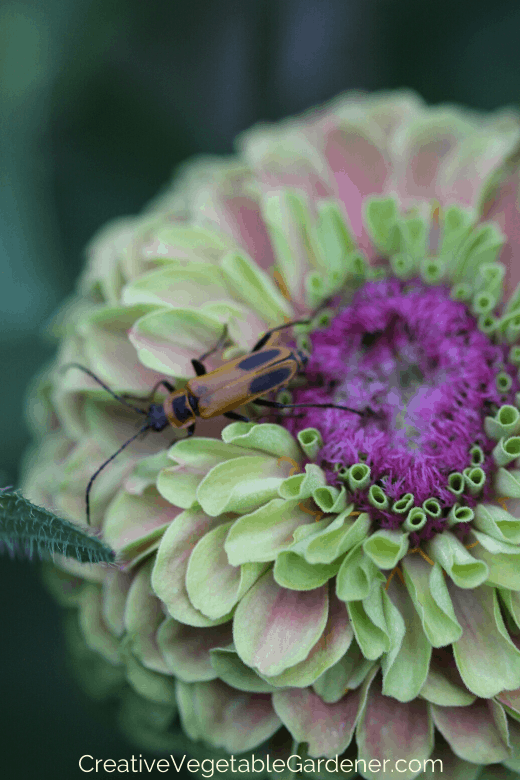
How to Plant Flowers in Raised Beds
How do you plant your flowers, you ask? There are two options: direct seeding or planting seedlings. I personally prefer to plant all of my flowers as seedlings to get a jump start on the season. I want flowers as soon as I can get them!Direct seed means at the correct time in the season (you can find this on the seed packet) you’ll simply remove some seeds from the seed packet and plant them right into the garden soil.
Cut Flowers You Can Direct Seed
Black-eyed Susan (can also be started indoors)
Zinnia (can also be started indoors)
Planting seedlings means you’re going to tuck a baby plant into your garden bed. This plant will be one that you start indoors yourself or purchase from someone else. If you already start your own vegetable seeds at home you can just integrate the flowers into your seed starting calendar. Easy peasy!
Or, you can shop at your local nursery or farmers market like we talked about above.
Cut Flowers You Should Start Indoors or Purchase as Plants
Black-eyed Susan (can also be direct seeded)
Globe Amaranth
Verbena bonariensis
Salvia
Zinnia (can also be direct seeded)
More Resources for Growing Cut Flowers in Your Garden
Take my most popular workshop, Design Inspiration for a Creative Vegetable Garden. I share fresh ideas to elevate an ordinary garden to an extraordinary one with plenty of photos to get the creative juices flowing. Learn how to design a garden that inspires joy, tips for adding artistic touches, and favorite colorful and unique varieties to grow.

As a garden educator, I get sent a lot of gardening books by publishers. I read through them all and most of them end up in the Little Library in my neighborhood. Only my absolute favorite books end up on my living room bookshelf.
The Cut Flower Garden is a gorgeous book packed with lots of well-organized, useful information. Reading it will get you super excited to grow cut flowers in your garden this season! Click here to purchase.
.


A Year in Flowers: Designing Gorgeous Arrangements for Every Season
Once you get the hang of growing cut flowers the next step is mastering how to artfully arrange them into stunning bouquets you can scatter around your house to bring you joy all season long. This is the follow up book to Floret Farm’s Cut Flower Garden. Click here to purchase.
.


Vegetables Love Flowers: Companion Planting for Beauty and Bounty
One of my favorite gardening books is a holistic view of why and how mixing flowers in with our vegetables benefits us, our plants, and the animals and insects that are a part of our garden ecosystems. Click here to purchase.
.


Floret Farm’s Cut Flower Garden Journal
I highly recommend keeping notes about your garden each year. This allows you to keep an eye on what’s working, what needs improvement and helps you think through how you can keep getting better as a gardener. This journal would be perfect for just that! Click here to purchase.
.
If you don’t currently mix flowers in with your vegetables, this is the year to try it! Plant some of these fabulous flowers for raised beds and get ready to have fun creating bouquets to brighten up every room in your house.
Get a behind the scenes tour of how I use flowers in my vegetable garden design to add beauty and color to my front yard in the video included in this post.
Read more about adding beauty to your vegetable garden:
- How to Grow a Colorful Garden
- 5 Ways to Create an Artistic Garden
- Easy & Beautiful DIY Garden Trellis
The post Fabulous Flowers For Raised Beds appeared first on Creative Vegetable Gardener.

